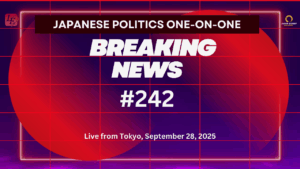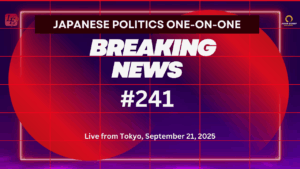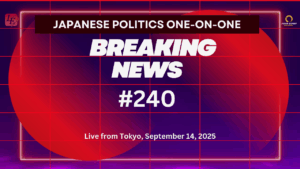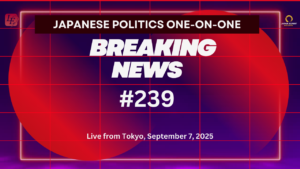Good morning from the historic port of Itō on the eastern edge of Sagami Bay. This week’s election-day Sunday Briefing marked a moment of transition, held on the very day of Japan’s pivotal Upper House race. With Mount Fuji gleaming in the distance and cicadas emanating a full cacophony of sounds, we covered volatile currency movements, looming U.S. tariffs, and the political fate of prime minister Ishiba. For our loyal JapanHands community, here’s a polished synopsis of Episode #232:
This Week’s Headlines
- The yen closed at 148.81 after a volatile week, with markets on edge ahead of election fallout and U.S. tariff imposition August 1.
- Upper House elections today could end LDP–Komeito dominance; fringe parties gain traction.
- PM Ishiba’s fragile grip on power even more tenuous—Kishida and Asō waiting in the wings; Tamaki of DPFP rumored to seek premiership under coalition deal.
- Japan braces for reactivated 25% U.S. tariffs on autos and pharma; Akazawa heads to Washington for his 9th trip.
- Seasonal shifts: the rainy season (tsuyu) ends, cicadas emerge, Mt. Fuji opens; tourism booms beyond urban centers (Ito is packed, for example, with traveling families and a noticeable flood of tourists.).
- Foreign residents under scrutiny amid campaign rhetoric; new agency launched to monitor compliance.
- 80th anniversary of USS Indianapolis sinking prompts reflection on Japan–U.S. wartime memory. O-bon and the significance of August builds.
Currency & Economic Pressures
The yen ended the week at 148.81 to the dollar, after a turbulent range between 147 and 149.05. While the BOJ held its rate at 0.5%, it continues tapering JGB purchases through 2027. The Fed, meanwhile, has paused rate cuts due to resilient U.S. data (which increasingly looks good), but tensions between the Administration and Fed Chair Powell continue to rattle confidence. Analysts warn that breaching the ¥/$150 threshold could trigger rapid capital flight.
Diplomacy & Tariffs
The U.S. is reactivating 25% tariffs on Japanese autos and pharma under Trump’s ‘Liberation Day’ doctrine. Exports have already plummeted—autos down 26.7%, pharma down 40%. Treasury Secretary Bessent’s whirlwind trip to Japan offered no real progress; he attended Expo events and briefly met PM Ishiba, but avoided substantive tariff discussion. Minister Akazawa will make his 9th trip to D.C. this week, though many observers believe the outcome is preordained. Industry leaders are rejecting a proposed 10% compromise, arguing even that would be too painful.
Upper House Elections & Political Turmoil
Today’s election puts 124 seats (half of the Upper House) on the line. The ruling LDP/Komeito coalition needs 50 to retain majority control, but early signs point to losses. Voter anger over inflation, high rice prices, and weak stimulus has emboldened fringe parties like Sanseito and Reiwa. Tamaki of the Democratic Party for the People is reportedly eyeing the premiership as a condition for joining a post-election coalition. Behind the scenes, Kishida and Asō are already maneuvering for their return to power. Tonight’s results and Ishiba’s tone will reveal the road ahead.
Fringe Parties, Youth Vote, and a Changing Political Architecture
Japan’s political structure is shifting. Factions have faded—only Asō’s remains intact—and the once-ceremonial Upper House now plays a decisive role. Young voters have become a swing bloc. Voter turnout is expected to be high, even on a three-day weekend, judging from a surge in advance voting. New parties and unorthodox candidates are storming the gates, reflecting discontent with entrenched leadership.
Crime, Foreigners & Campaign Rhetoric
On July 15, the prime minister launched a new oversight agency to monitor foreign resident compliance with taxes, insurance, and driving laws. Media and political rhetoric has cast a spotlight on foreigners, especially short-term visitors as convenient scapegoats for rising anxieties. But actual crime rates remain low. More established political voices are pushing back against the insinuation that foreigners are burdening Japan’s systems.
Seasonal Markers & Cultural Reflection
With the official end of the rainy season (tsuyu), Japan slides into high summer. Cicadas drone loudly, Mt. Fuji is open for climbers, and hot spring towns in rural Japan are bustling with inbound tourism. Tourists, especially repeat visitors, are venturing beyond Tokyo and Kyoto in search of something more authentic.
USS Indianapolis: Memory & Misrepresentation
This week marks the 80th anniversary of the sinking of the USS Indianapolis. Struck by two Japanese torpedoes and sunk in minutes. 930 of 1,195 crew were lucky enough to get into the water (~25% went down with the ship, unable to escape). Only 316 survived (25%). The movie Jaws sensationalized the Indianapolis and its secret mission to deliver components for the Hiroshima-bound atomic bomb, it exaggerated the shark attacks. In point of fact, most deaths came from drowning, exposure and dehydration after 4 days in open water. The story underscores how war memory is shaped. This season is one of remembrance; events at Yasukuni Shrine and remarks from the Emperor are poignantly anticipated.
Q&A Highlights
• What about a potential backroom deal between prime minister Ishiba and Ishin? You noted Secretary Bessent’s trip lacked substance. Isn’t this a great signal of the strength of The Relationship?
• Shouldn’t Ishiba step down? You explored scenarios involving Tamaki and coalition realignment, can you describe a bit further?
• Some see a relationship between Sanseito’s rise and the weak yen; what do you think… aren’t the key issues tied to economic frustration?
• How Japanese politicians are trained? How are they vetted in order to finally even just qualify as a candidate?
• Isn’t it a rarity for long-serving PMs? Japan’s fragile leadership cycles seem to be the dominant role with so very few surviving 3.5 years.
Final Thoughts
On this humid July morning from the port of Itō, the air was thick not just with cicadas, but with political suspense. The tide may be turning in Japan toward a new coalition, a new prime minister, and a generation demanding more than recycled policies. As ballots are counted and deals cut, we’ll be watching. For now, I’ll soak in an onsen, savor the quiet, and prepare for the 9-hour sail home tomorrow. Japan is truly now a country in transition. It feels like something fundamental is shifting not only politically, but generationally.
Are you familiar with “Tokyo on Fire”? Episodes are available on YouTube “Langley Esquire”: excruciatingly-gained insights sifted over 40 years in-country! Entertainingly presented.
“Japanese Politics One-on-One” episodes are on YouTube “Japan Expert Insights”.
If you gain insight from these briefings, consider a tailored one for your Executive Team or for passing-through-Tokyo heavyweights.
To learn more about advocacy in Japan, read our article “Understanding the Dynamics of Lobbying in Japan.”
Join the Success!
Experience exceptional, personalized solutions designed to meet your business’s specific needs. Discover how we can elevate your operations to the next level.




